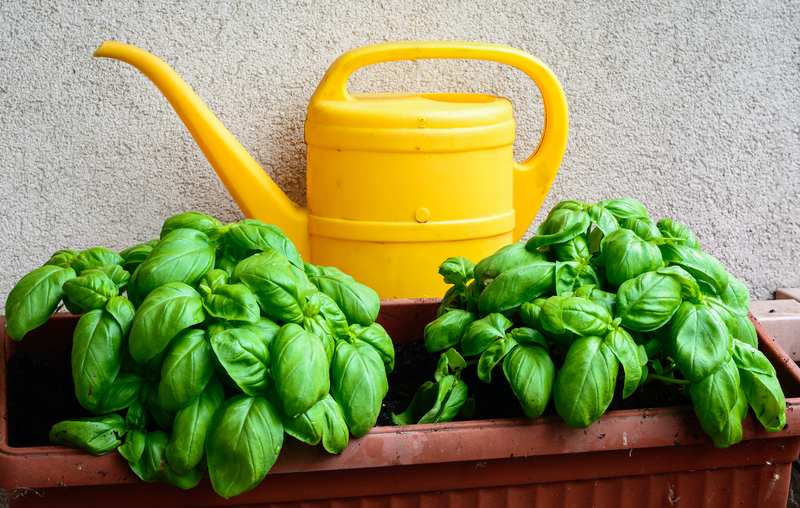Revamping Waste into Nutrient-Dense Earth
Posted on 23/09/2025
Revamping Waste into Nutrient-Dense Earth: An Eco-Conscious Revolution
Imagine a world where food scraps, yard clippings, agricultural byproducts, and even paper are no longer trash, but instead, the very foundation of rich, vibrant soil. This is not just hopeful thinking--it's the essence of revamping waste into nutrient-dense earth. In our pursuit of environmental sustainability and robust food systems, understanding how to transform organic waste into fertile soil is crucial.
What Does "Revamping Waste into Nutrient-Dense Earth" Really Mean?
At its core, revamping waste into nutrient-dense soil refers to transforming what we traditionally consider refuse--like kitchen scraps or garden prunings--into organic matter that nourishes the earth. This process replenishes soil health, sequesters carbon, and closes the loop between consumption and creation. The many methods--composting, vermiculture, anaerobic digestion, and more--offer scalable solutions to individual households, farms, and cities alike.
Why Is This Transformation So Important?
Every year, billions of tons of organic waste are sent to landfills, contributing to methane emissions and squandering precious nutrients. By transforming waste into soil enhancement, we not only cut down on greenhouse gases but also restore life to depleted soils, empowering communities to take control of their food security and environmental impact.
Here's why upcycling waste into nutrient-rich earth deserves your attention:
- Reduces landfill burden: Diverts organic waste away from overflowing dumpsites.
- Combats climate change: Prevents excess methane--a potent greenhouse gas--by decomposing organic matter aerobically.
- Improves soil health: Replenishes nutrients and fosters beneficial soil organisms.
- Supports local agriculture: Offers growers a sustainable alternative to chemical fertilizers.
- Creates economic opportunities: Fosters green businesses and community projects built around waste cycling.

Understanding the Science Behind Waste-to-Earth Transformation
The journey from waste to nutrient-rich earth isn't magic--it's science and ancient wisdom combined. The process is driven by decomposers (bacteria, fungi, earthworms) that break down organic matter. Key elements involved in this transformation include:
- Carbon: Ingredients like dried leaves, twigs, and cardboard.
- Nitrogen: Found in food scraps, grass clippings, and coffee grounds.
- Moisture: Essential for microbial activity and chemical reactions.
- Oxygen: Aerobic microbes need it to thrive and decompose matter efficiently.
By balancing these elements, we can create an environment where organic waste is efficiently transformed into humus-rich compost--the gold standard of soil amendments.
Composting: Nature's Miracle Engine
Composting remains the most popular way households and communities turn waste into nutrient-dense soil. Through controlled aerobic decomposition, composting transforms banana peels, eggshells, and dry leaves into crumbly, earthy-smelling compost that teems with beneficial microorganisms. Hot composting accelerates this process through careful temperature management, while cold composting requires less work but takes longer.
Vermicomposting: Harnessing the Power of Worms
A shining star in organic waste reuse, vermicomposting employs red wigglers or other composting worms to process kitchen scraps. The result is worm castings--a nutrient powerhouse that improves plant root structures, boosts microbial life, and holds soil moisture like a sponge.
Black Soldier Fly Larvae: Future-Forward Waste Transformation
Increasingly, farms and even urban operations are using black soldier fly larvae in bioconversion systems to devour food waste at a startling rate. These larvae convert waste into high-protein feedstocks for animals, while their residue forms a rich soil amendment, closing multiple ecological cycles at once.
From Household Scraps to Flourishing Soil: A Step-by-Step Guide
Step 1: Collect and Segregate Your Waste
- Green waste: Vegetable peels, fruit scraps, coffee grounds, fresh grass clippings
- Brown waste: Fallen leaves, shredded paper, sawdust, cardboard
- Avoid: Dairy, meat, oils, treated wood, or anything synthetic, as these slow decomposition and may attract pests
*Tip: Keep a small container in your kitchen for daily scraps to make collecting easier.
Step 2: Balance Your Pile
A successful waste-to-soil system needs a balanced mix of carbon (browns) and nitrogen (greens). Aim for approximately three parts carbon to one part nitrogen to optimize decomposition.
Step 3: Maintain Moisture and Aeration
Turn your pile every few weeks to bring fresh oxygen to the mix, and make sure it feels like a wrung-out sponge--not too dry, not soggy. Aeration prevents foul odors and ensures beneficial microbes thrive.
Step 4: Be Patient and Observe
In a few months (sometimes sooner with the right conditions), the waste mixture will transform. When the finished product is uniform, dark, and smells earthy, you've completed the transformation of waste into nutrient-dense earth!
Beyond Compost: Innovative Approaches to Upcycling Waste
Bokashi Fermentation
Bokashi is an anaerobic (oxygen-free) process using specific microorganisms to ferment kitchen scraps, including dairy and meat. Once treated, the fermented waste is safe to bury in the garden, where it rapidly decomposes, enriching the soil with nutrients and beneficial bacteria.
Biochar Integration
Biochar--charcoal produced from plant matter--holds immense promise for soil health. When added to compost or directly to soil, biochar increases nutrient retention, improves water holding capacity, and sequesters carbon, amplifying the benefits of waste-enhanced earth.
Industrial-Scale Anaerobic Digesters
Cities and farms are installing anaerobic digesters to process tons of organic waste, producing renewable energy (biogas) and nutrient-rich digestate that serves as a powerful fertilizer. This method helps close the loop on urban food systems at scale.
Soil Regeneration and Planetary Health: The Ripple Effects
- Nutrient cycling: Organic matter returned to soil supplies crops with slow-release nutrients, reduces erosion, and boosts yields.
- Ecosystem restoration: Reinvigorated soils support greater biodiversity, from beneficial microbes to pollinators and earthworms.
- Climate mitigation: Healthy soils store more carbon, helping combat global warming and improve climate resilience.
- Toxin remediation: Compost can help break down pollutants, acting as a natural filter for contaminated sites.
Revamping Waste in Different Contexts
Urban Households and Community Gardens
City dwellers may feel disconnected from natural soil cycles, but even a balcony or rooftop can harbor a compost bin. Community composting initiatives make it easy to pool resources, while educational workshops inspire new generations to see "waste" in a new light.
Farms and Rural Properties
Farmers benefit massively from integrating organic waste recycling into soil production. Crop residues, animal manures, and food processing byproducts can be composted or digested, closing the loop and reducing input costs for fertilizer.
Municipal and Circular Economy Solutions
Cities are piloting large-scale composting, biogas, and black soldier fly facilities, upcycling food waste at significant scales. These efforts reduce landfill stress, improve local food security, and create green jobs.
Common Misconceptions About Transforming Waste into Nutrient-Dense Earth
-
"It's too complicated."
Most composting methods can fit into your lifestyle with a little planning. Simple worm bins or small outdoor piles work wonders. -
"Compost piles smell bad."
Properly balanced piles are odorless or have a pleasant earthy aroma. Foul smells signal too much moisture or nitrogen--add more carbon and turn the pile. -
"It attracts pests."
Careful management and a cover (or sealed bin) will keep rodents and flies away. -
"It takes too long."
Hot composting can yield usable soil amendments in as little as eight weeks!
Revamping Waste Supports Sustainability Goals
Transforming waste into nutrient-rich soil is directly aligned with several United Nations Sustainable Development Goals (SDGs), including:
- Zero Hunger (SDG 2): Healthier soils produce more nutritious crops, directly impacting food security.
- Responsible Consumption and Production (SDG 12): Closing the production-consumption loop minimizes waste.
- Climate Action (SDG 13): Composting and organic waste diversion reduce greenhouse gas emissions and increase carbon sinks.
Practical Ways to Start Revamping Waste into Nutrient-Dense Earth at Home
- Audit your waste stream: Note what you throw away the most and identify compostable items.
- Choose the right method: Traditional composting, worm bins, or bokashi are all accessible to beginners.
- Get the neighborhood involved: Sharing a composter or volunteering at a community garden amplifies your impact.
- Use finished compost in pots, gardens, or to enrich lawn soil.
- Advocate for composting in schools and workplaces.
*Small actions, multiplied by millions, create a world-changing movement!*

The Future: Technological Advancements in Organic Waste Upcycling
Agricultural engineering, biotechnology, and urban design are converging to make waste-to-soil conversion more efficient. Innovations like smart composters automate temperature and moisture monitoring, while microbial inoculants supercharge decomposition. Digital mapping helps cities optimize waste collection routes and track environmental benefits in real time.
Even more exciting, the adoption of circular economy principles means companies are designing products--like compostable plastics--that feed directly into organic recycling streams, reducing dependency on fossil fuels and recovering vital nutrients.
Conclusion: Revamping Waste into Nutrient-Dense Earth--A Path Forward
The era of viewing organic waste as worthless is over. Today, revamping waste into nutrient-dense earth stands at the heart of regenerative agriculture, sustainable cities, and homes that care about future generations. Whether you start a simple backyard compost pile, join a neighborhood initiative, or innovate at scale, every action brings us closer to a world sustained by healthy, living soils.
It's time to see every banana peel, yard trimmings, and coffee ground not as garbage, but as the seeds of tomorrow's thriving earth.
Join the revolution. Transform your waste. Grow the future--one handful of earth at a time.

